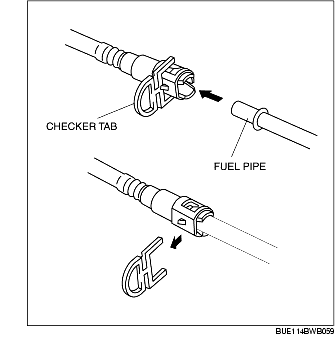
1. Follow BEFORE SERVICE PRECAUTION to perform the 'Fuel Line Safety Procedure' before servicing the fuel system quick release connector, and wipe off the foreign material on the surface of the connecting area. (See BEFORE SERVICE PRECAUTION [L3].)
2. Rotate the quick release connector release tab to the stopper position.
3. Pull out the quick connector straight from the pipe and disconnect it.
4. Cover the disconnected quick release connector and pipe with vinyl sheeting or a similar material to prevent it from becoming scratched or dirty.

1. Inspect the fuel hose and pipe sealing surface for damage and deformation.
2. Apply a small amount of clean engine oil to the sealing surface of the pipe.
3. Reconnect the fuel hose straight to the pipe until a click is heard.
4. Lightly pull and push the quick release connector a few times by hand, and then verify that it can move (2-3 mm {0.079-0.118 in}) and is connected securely.
5. Inspect all related parts by performing AFTER SERVICE PRECAUTION. (See AFTER SERVICE PRECAUTION [L3].)
1. Follow BEFORE SERVICE PRECAUTION to perform the 'Fuel Line Safety Procedure' before servicing the fuel system quick release connector, and wipe off foreign material on the surface of the connecting area. (See BEFORE SERVICE PRECAUTION [L3].)
2. Insert the SST into the quick release connector.
3. Pull out the quick release connector straight from the pipe and disconnect it.
4. Cover the disconnected quick release connector and pipe with vinyl sheeting or a similar material to prevent it from becoming scratched or dirty.
1. Follow BEFORE SERVICE PRECAUTION to perform the 'Fuel Line Safety Procedure' before servicing the fuel system quick release connector, and wipe off foreign material on the surface of the connecting area. (See BEFORE SERVICE PRECAUTION [L3].)
2. Using a flathead screwdriver, push in the retainer locking one by one to release the lock of the retainer and pipe.
3. Pull out the quick release connector straight from the pipe and disconnect it.
4. Cover the disconnected quick release connector and pipe with vinyl sheeting or a similar material to prevent it from becoming scratched or dirty.

1. Inspect the fuel hose and pipe sealing surface for damage and deformation.
2. Reconnect the fuel hose straight to the pipe until a click is heard.
3. Lightly pull and push the quick release connector a few times by hand, and then verify that it is connected securely.
4. Inspect all related parts by performing AFTER SERVICE PRECAUTION. (See AFTER SERVICE PRECAUTION [L3].)
1. Remove the retainer remaining on the pipe side.
2. Install a new retainer to the quick release connector.
3. Reconnect the hose straight to the pipe until a click is heard.
4. Lightly pull and push the quick release connector a few times by hand, and then verify that it is connected securely.
5. Inspect all related parts by performing AFTER SERVICE PRECAUTION. (See AFTER SERVICE PRECAUTION [L3].)
1. Remove in the order indicated in the figure.
1. Install in the reverse order of removal.
1. Remove in the order indicated in the figure.
1. Install in the reverse order of removal.
1. Remove in the order indicated in the figure.
1. Install in the reverse order of removal.
1. Remove in the order indicated in the figure.
1. Install in the reverse order of removal.